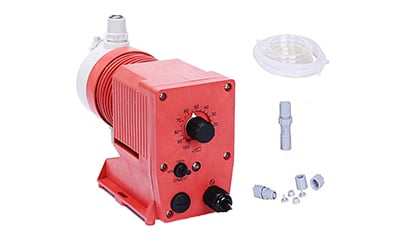Accessory package includes: bottom valve, injection valve, 2 m suction line and 5 m drain line.
What are the components of a complete metering pump head?
A complete hydraulic end includes the following components: pump head, diaphragm, valve, backplane and mounting bolts.
What is the main purpose of the bottom valve?
The bottom valve itself has a weight that keeps the suction line straight and perpendicular to the chemical barrel. In addition, it is also a non-return valve to maintain the positive flow of the chemical liquid. The bottom valve also helps to improve pump repeatability and normal suction. The bottom valve has a screen to prevent solid particles from being inhaled into the suction line. Small solid particles inhalation may lead to metering pump diaphragm damage. The bottom valve also includes a fitting for connecting the suction pipe. The bottom valve should be installed vertically and kept a certain distance away from the bottom of the drug storage barrel. For most of the self-priming work metering pump bottom valve selection is very necessary.
What are the main uses of injection valves?
Injection valves are used to connect the drain line to the injection point. Injection valves should not be used as isolation devices or as protection against siphoning. For less demanding applications, the injection valve can produce back pressure of 0.5bar.
What is the main purpose of the flushing equipment?
Flushing equipment is used to clean the pump head and drain line of metering pumps. It is mainly used when metering chemicals are easy to set or when the metering pump needs to be constantly idle.
What is a float switch and what is its main function?
Float switch is the key equipment to control the liquid level of medicine storage barrel. When the liquid level drops, the float sinks and the internal contact of the switch closes. This contact can be used to control the metering pump, such as stopping the metering pump 1 and starting the metering pump 2. It can also be used to turn on the alarm/indicator light to indicate that the drug storage barrel is empty. By the reverse action of the float, the float switch can be applied to the collection tank to indicate that the collection tank is full and the metering pump is stopped.
What is the difference between a single-stage float switch and a two-stage float switch?
When the switch is operated, the single-stage float switch stops the metering pump directly. For the two-stage float switch, the activation of stage * can be used to alarm to indicate the low liquid level of the drug storage barrel. When the stage switch is activated, the metering pump stops.
What is a multi-function valve?
Multi-function valve is a very universal product, it can produce constant back pressure, to ensure repeated metering accuracy. An integrated anti-siphon valve prevents chemicals from being sucked into the vacuum line and prevents venturi effect or negative delivery head in the waterway. The device is integrated with a pressure relief valve to protect metering pumps, pipelines and other system equipment from overpressure when the system line is blocked. The multi-function valve is also integrated with the function of a suction valve, which can release the pressure of the drainage pipeline and help the metering pump suction. The multi-function valve allows the discharged liquid to safely return to the drug storage barrel.
What is the main function of a traffic monitor?
Flow monitoring is activated at each flow pulse action using a proximity switch. The metering pump compares the discharge stroke with the number of pulses observed by the flow monitor. If the pump cannot detect the corresponding pulse signal for 8 consecutive strokes or the set number of strokes, the metering pump will stop and issue a fault indication. The flow monitor can send an alarm when the suction line is empty, blocked or leaking, the drain line is blocked, the diaphragm is damaged, etc., by detecting no pulse signal. If the metered flow is reduced by 20% or below the set value, the proportional flow monitor can detect it.
What are the main uses of fault alarm relays and step relays?
Alarm relay in metering pump failure contact open (NC) or closed (NO). When the metering pump fails, the synchronous relay is closed. Usually the synchronous relay is attached to the metering pump to produce the same frequency as the main metering pump.
What are the main uses of pulse dampers?
Selecting a pulse damper of the right size can reduce the pulsation by 90% or more, resulting in a flow close to laminar flow. A pulse damper reduces the acceleration of the measured medium and reduces head loss.
What is the difference between the function of the buffer and the impulse damper?
The buffer can reduce the pulsation of the pipeline, reduce the acceleration of the medium and reduce the head loss. There is no separation of liquid and gas in the buffer. The buffer chamber will eventually be filled with liquid and will need to be drained.
What is a diaphragm rupture monitor and how does it work?
A drain hole is arranged on the back plate between the drive end and the pump head, and a conduit connects the drain hole to a small cylindrical cylinder. If the diaphragm is ruptured, the fluid is drained through the drain hole into the small cylinder. The cylinder contains a float switch that can be activated as long as 10ml of liquid is in the cylinder. Switch contacts can be set to normally open or normally closed.
If you need metering pump products, pump accessories or related technical support, please contact us .





